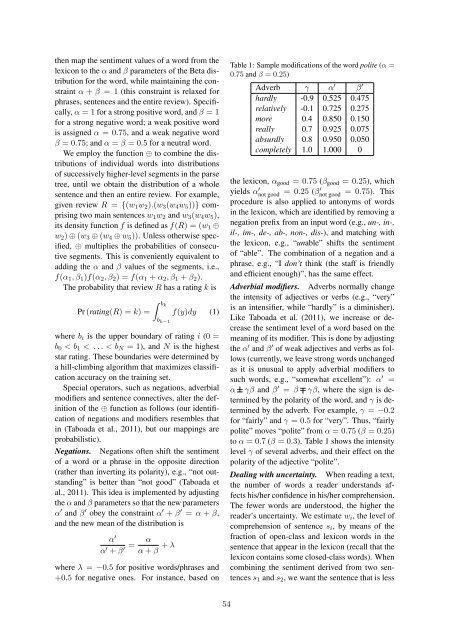Full proceedings volume - Australasian Language Technology ...
Full proceedings volume - Australasian Language Technology ...
Full proceedings volume - Australasian Language Technology ...
Create successful ePaper yourself
Turn your PDF publications into a flip-book with our unique Google optimized e-Paper software.
then map the sentiment values of a word from the<br />
lexicon to the α and β parameters of the Beta distribution<br />
for the word, while maintaining the constraint<br />
α + β = 1 (this constraint is relaxed for<br />
phrases, sentences and the entire review). Specifically,<br />
α = 1 for a strong positive word, and β = 1<br />
for a strong negative word; a weak positive word<br />
is assigned α = 0.75, and a weak negative word<br />
β = 0.75; and α = β = 0.5 for a neutral word.<br />
We employ the function ⊕ to combine the distributions<br />
of individual words into distributions<br />
of successively higher-level segments in the parse<br />
tree, until we obtain the distribution of a whole<br />
sentence and then an entire review. For example,<br />
given review R = {(w 1 w 2 ).(w 3 (w 4 w 5 ))} comprising<br />
two main sentences w 1 w 2 and w 3 (w 4 w 5 ),<br />
its density function f is defined as f(R) = (w 1 ⊕<br />
w 2 ) ⊕ (w 3 ⊕ (w 4 ⊕ w 5 )). Unless otherwise specified,<br />
⊕ multiplies the probabilities of consecutive<br />
segments. This is conveniently equivalent to<br />
adding the α and β values of the segments, i.e.,<br />
f(α 1 , β 1 )f(α 2 , β 2 ) = f(α 1 + α 2 , β 1 + β 2 ).<br />
The probability that review R has a rating k is<br />
Pr (rating(R) = k) =<br />
bk<br />
b k−1<br />
f(y)dy (1)<br />
where b i is the upper boundary of rating i (0 =<br />
b 0 < b 1 < . . . < b N = 1), and N is the highest<br />
star rating. These boundaries were determined by<br />
a hill-climbing algorithm that maximizes classification<br />
accuracy on the training set.<br />
Special operators, such as negations, adverbial<br />
modifiers and sentence connectives, alter the definition<br />
of the ⊕ function as follows (our identification<br />
of negations and modifiers resembles that<br />
in (Taboada et al., 2011), but our mappings are<br />
probabilistic).<br />
Negations. Negations often shift the sentiment<br />
of a word or a phrase in the opposite direction<br />
(rather than inverting its polarity), e.g., “not outstanding”<br />
is better than “not good” (Taboada et<br />
al., 2011). This idea is implemented by adjusting<br />
the α and β parameters so that the new parameters<br />
α and β obey the constraint α + β = α + β,<br />
and the new mean of the distribution is<br />
α <br />
α + β =<br />
α<br />
α + β + λ<br />
where λ = −0.5 for positive words/phrases and<br />
+0.5 for negative ones. For instance, based on<br />
Table 1: Sample modifications of the word polite (α =<br />
0.75 and β = 0.25)<br />
Adverb γ α β <br />
hardly -0.9 0.525 0.475<br />
relatively -0.1 0.725 0.275<br />
more 0.4 0.850 0.150<br />
really 0.7 0.925 0.075<br />
absurdly 0.8 0.950 0.050<br />
completely 1.0 1.000 0<br />
the lexicon, α good = 0.75 (β good = 0.25), which<br />
yields αnot good = 0.25 (β not good<br />
= 0.75). This<br />
procedure is also applied to antonyms of words<br />
in the lexicon, which are identified by removing a<br />
negation prefix from an input word (e.g., un-, in-,<br />
il-, im-, de-, ab-, non-, dis-), and matching with<br />
the lexicon, e.g., “unable” shifts the sentiment<br />
of “able”. The combination of a negation and a<br />
phrase, e.g., “I don’t think (the staff is friendly<br />
and efficient enough)”, has the same effect.<br />
Adverbial modifiers. Adverbs normally change<br />
the intensity of adjectives or verbs (e.g., “very”<br />
is an intensifier, while “hardly” is a diminisher).<br />
Like Taboada et al. (2011), we increase or decrease<br />
the sentiment level of a word based on the<br />
meaning of its modifier. This is done by adjusting<br />
the α and β of weak adjectives and verbs as follows<br />
(currently, we leave strong words unchanged<br />
as it is unusual to apply adverbial modifiers to<br />
such words, e.g., “somewhat excellent”): α =<br />
α ± γβ and β = β ∓ γβ, where the sign is determined<br />
by the polarity of the word, and γ is determined<br />
by the adverb. For example, γ = −0.2<br />
for “fairly” and γ = 0.5 for “very”. Thus, “fairly<br />
polite” moves “polite” from α = 0.75 (β = 0.25)<br />
to α = 0.7 (β = 0.3). Table 1 shows the intensity<br />
level γ of several adverbs, and their effect on the<br />
polarity of the adjective “polite”.<br />
Dealing with uncertainty. When reading a text,<br />
the number of words a reader understands affects<br />
his/her confidence in his/her comprehension.<br />
The fewer words are understood, the higher the<br />
reader’s uncertainty. We estimate w i , the level of<br />
comprehension of sentence s i , by means of the<br />
fraction of open-class and lexicon words in the<br />
sentence that appear in the lexicon (recall that the<br />
lexicon contains some closed-class words). When<br />
combining the sentiment derived from two sentences<br />
s 1 and s 2 , we want the sentence that is less<br />
54














